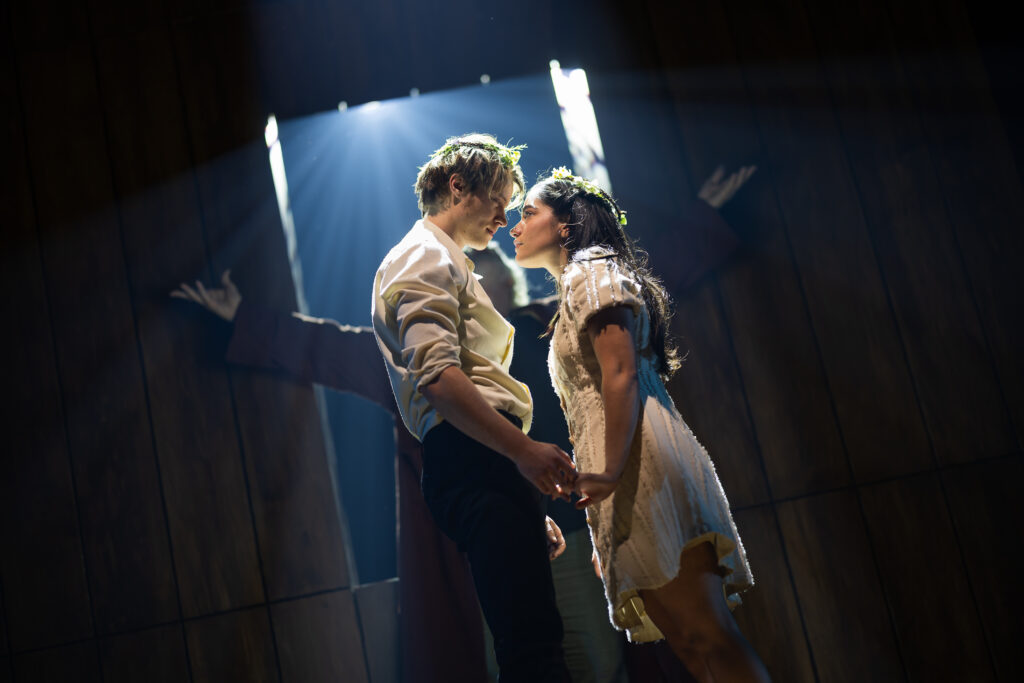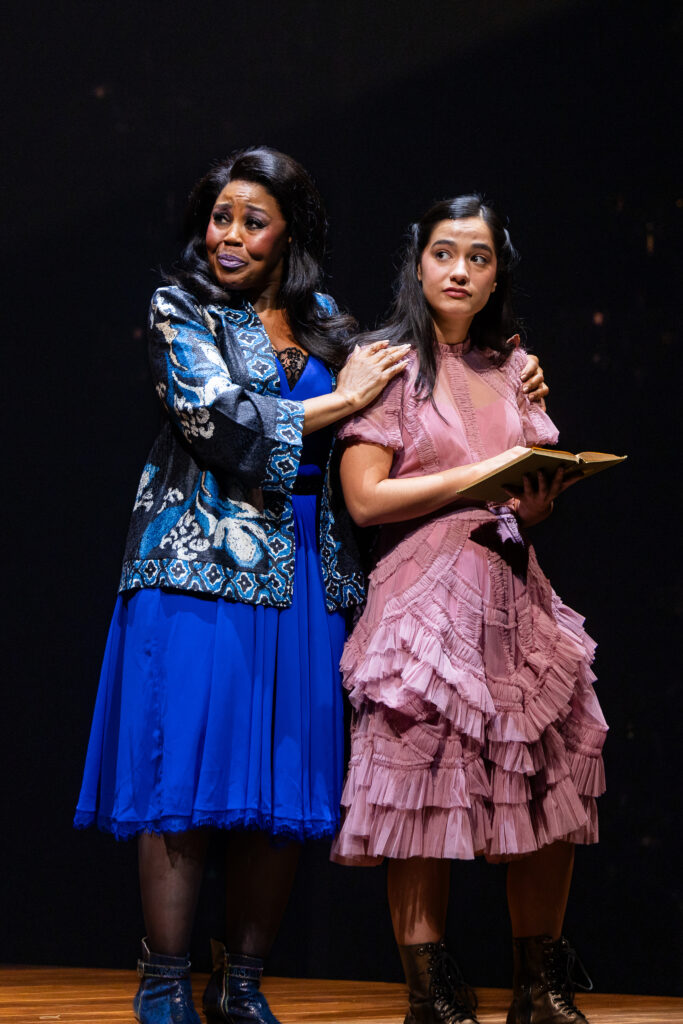
Rudy Pankow (Romeo) and Emilia Suárez (Juliet), credit: Nile Scott Studios and Maggie Hall.
Presented by American Repertory Theater
Play by William Shakespeare
Direction by Diane Paulus
Movement direction and choreography by Sidi Larbi Cherkaoui
Scenic design by Amy Rubin
Costume design by Emilio Sosa
Lighting design by Jen Schriever
Sound design by Daniel Lundberg
Original music by Alexandre Dai Castaing
Featuring: Terence Archie, Sharon Catherine Brown, Brandon Dial, Terrance Mann, Rudy Pankow, Clay Singer, Emilia Suárez, Nicole Villamil
August 31 – October 6
Loeb Drama Center
64 Brattle Street
Cambridge MA 02138
Tickets here
Article by Maegan Bergeron-Clearwood
CAMBRIDGE, Mass. — Shakespeare’s most ubiquitous tragic romance hinges on the duality between love and hate. In Director Diane Paulus’ program note, she expresses a desire to tip the scale toward love, but this A.R.T. production is most successful in its exploration of another duality: that of tradition and rebellion; the tension between one generation and the next.
Father Lawrence (Terrance Mann) is our viewpoint character, and arguably even our protagonist, in this riveting new staging. A hippie gardener who loves love, he is not only the titular characters’ well-intentioned father figure, but also the play’s voice of reason, despair, compassion, and remorse. The dramaturgical choice to have him deliver the play’s famous opening and closing monologues, combined with Mann’s warm but commanding demeanor, place him at the center of a story that is ostensibly about teenage love.
In fairness, Rudy Pankow and Emilia Suárez as Romeo and Juliet respectively make for a formidable pair. Pankow swallows some of his lines, but approaches Romeo with an impassioned, nervous energy. Juliet is one of my favorites of Shakespeare’s characters with a surprising amount of backstory and motivation for a romantic heroine. Suárez takes advantage of all the character has to offer by leaning into Juliet’s desperation to escape an arranged marriage.
Still, the most compelling scenes in this production are those between Romeo and Juliet and their parental figures, resulting in a particularly strong second half. Sharon Catherine Brown is no tired old Nurse (indeed, all the lines referencing her age are played with jovial irony) but instead a vivacious, complex woman in her own right. Her generous but guarded relationship with Juliet makes for a riveting foil to Friar Lawrence’s with Romeo.
It’s Nicole Villamil’s woman-on-the-edge-of-a-breakdown portrayal of Lady Capulet that will linger with me the longest. Bedecked in gowns and heels (costume design by Emilio Sosa), she is holding onto her family’s sense of normalcy by a thread, torn between social pressure to marry her daughter off to the highest bidder and her own haunting memories of an arranged marriage. Villamil’s embodiment of a woman who wants to love her daughter but doesn’t know how made me realize, for the first time, that this play has not two, but three fascinating female characters.

Sharon Catherine Brown and Emilia Suárez. Photo credit: Nile Scott Studios and Maggie Hall.
The production’s performative and dramaturgical strengths are scaffolded by a synergetic visual design. A sleek wooden wall rotates and transforms into a surprising array of scenic arrangements, gradually fracturing alongside the increasingly doomed plot. Amy Rubin’s dynamic scenic design accentuated by Jen Schriver’s lighting, which varyingly punctuates the world with hope or casts it into despair with geometric precision. Combined with Daniel Lundberg’s delicate sound design and Alexandre Dai Castaing’s haunting original music, the result is a simple but infinitely inventive spectator experience.
At times, aspects of the production are almost too entertaining, with some creative choices distracting from rather than propelling the story. This is particularly evident in the first two acts, when the play is trying to masquerade as a romantic comedy. Dick puns and goofy impersonations abound, particularly from Mercutio (Clay Singer), but not even Friar Lawrence is spared a dirty joke or two. This buoyant tone makes Mercutio and Tybalt’s deaths and the play’s subsequent plummet into tragedy feel that much more jarring, but the direction sometimes veers so far into slapstick that major plot beats and character moments get lost in the muddle.
Rarely do I return from intermission and find myself more engaged than before, but the A.R.T.’s production of Romeo and Juliet thrives in the darker, more intimate of this tonally expansive play. This production is about love, yes, but not romantic love so much as the imperfect, conflicted love between two generations that both think they know best – and all the horrifying consequences that may ensue if these conflicts linger unresolved.
